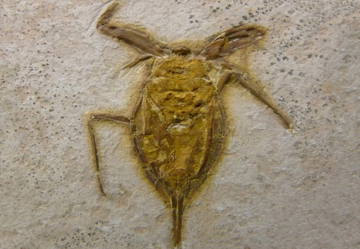Abstract
Burmese amber is currently the most popular and prolific source of fossil Hymenoptera, yielding a plethora of diverse and often unique fossils (Ross, 2020), and so vastly broadens and deepens our understanding of the mid-Cretaceous insect diversity in tropics in the midst of Tethys Ocean (Rasnitsyn & Öhm-Kühnle, 2018a; Zhang et al., 2018a). Parasitic wasps of the extinct superfamily Serphitoidea are a common, yet very unusual component of the Cretaceous microhymenopterans (Gibson et al., 2007; Engel, 2016; Rasnitsyn & Öhm-Kühnle, 2018a, b, 2020). Of them, Archaeoserphitidae represent a most basal and least explored branch known from a single find of two males in a piece of a comparatively ancient (Barremian) Lebanese amber (Engel, 2016). We identified the first female of Archaeoserphites Engel, 2016 in the comparatively younger, mid-Cretaceous Burmese amber and present its description in the publication on hand.
References
Cohen, K.M., Finney, S.C., Gibbard, P.L. & Fan, J.X. (2013; updated) The ICS International Chronostratigraphic Chart. Episodes, (36), 199–204. https://stratigraphy.org/ (accessed 22 March 2020).
https://doi.org/10.18814/epiiugs/2013/v36i3/002
Cruickshank, R.D. & Ko, K. (2003) Geology of an amber locality in the Hukawng Valley, northern Myanmar. Journal of Asian Earth Sciences, 21, 441–455.
https://doi.org/10.1016/S1367-9120(02)00044-5
Engel, M.S. (2016) A new family of primitive serphitoid wasps in Lebanese amber (Hymenoptera, Serphitoidea). Novitates Paleoentomologicae, 13, 1–22.
https://doi.org/10.17161/np.v0i13.5064
Gibson, G.A.P., Read, J.,& Huber, J.T. (2007) Diversity, classification and higher relationships of Mymarommatoidea (Hymenoptera). Journal of Hymenoptera Research, 16 (1), 51–146. Available from: https://www.researchgate.net/profile/John_Huber4/publication/281579951_Diversity_classification_and_higher_relationships_of_Mymarommatoidea_Hymenoptera/links/56c1e32208ae2f498efcd787/Diversity-classification-and-higher-relationships-of-Mymarommatoidea-Hymenoptera.pdf (accessed 28 January 2019).
Li, L., Shih, C., Rasnitsyn, A.P., Li, D. & Ren, D. (2018) A new wasp of Myanmarinidae (Hymenoptera: Stephanoidea) from the mid-Cretaceous Myanmar amber. Cretaceous Research, 86, 33–40.
https://doi.org/10.1016/j.cretres.2018.02.009
Maksoud, S. & Azar, D. (2020) Lebanese amber: latest updates. Palaeoentomology, 003 (2): 125–155.
https://doi.org/10.11646/palaeoentomology.3.2.2
Penteado-Dias, A.M. & Braga, S.M.P. (2002) First record of Mymarommatidae (Hymenoptera) from Brazil. Revista Brasileira de Zoologia, 19 (2), 629–630.
https://doi.org/10.1590/S0101-81752002000200018
Rasnitsyn, A.P. & Öhm-Kühnle, Ch. (2018a) Three new female Aptenoperissus from mid-Cretaceous Burmese amber (Hymenoptera, Stephanoidea, Aptenoperissidae): Unexpected diversity of paradoxical wasps suggests insular features of source biome. Cretaceous Research, 91, 168–175.
https://doi.org/10.1016/j.cretres.2018.06.004
Rasnitsyn, A.P. & Öhm-Kühnle, Ch. (2018b) New serphitoid wasp Supraserphites draculi gen. sp. nov. in Burmese amber (Hymenoptera, Serphitidae: Supraserphitinae). Cretaceous Research, 99, 46–50.
https://doi.org/10.1016/j.cretres.2018.12.006
Rasnitsyn, A.P. & Öhm-Kühnle, Ch. (2020) Two new species of Supraserphites (Hymenoptera, Serphitidae) in Burmese amber. Palaeoentomology, 3 (2): 158–162.
https://doi.org/10.11646/palaeoentomology.3.2.4
Rasnitsyn, A.P., Poinar Jr., G. & Brown, A.E. (2017) Bizarre wingless parasitic wasp from mid-Cretaceous Burmese amber (Hymenoptera, Ceraphronoidea, Aptenoperissidae fam. nov.). Cretaceous Research, 69, 113–118.
https://doi.org/10.1016/j.cretres.2016.09.003
Rasnitsyn, A.P., Bashkuev, A.S., Kopylov, D.S., Lukashevich, E.D., Ponomarenko, A.G., Popov, Y.A., Rasnitsyn, D.A., Ryzhkova, O.V., Sidorchuk, E.A., Sukatsheva, I.D. & Vorontsov, D.D. (2016) Sequence and scale of changes in the terrestrial biota during the Cretaceous (based on materials from fossil resins). Cretaceous Research, 61, 234–255.
https://doi.org/10.1016/j.cretres.2015.12.025
Ross, A. (2015) Insects in Burmese Amber. Entomologentagung 02.–05.03.2015 Frankfurt am Main, Programm und Abstracts. Frankfurt/Main, 72. Available from: https://www.researchgate.net/publication/273295234_Entomologentagung_02-05032015_FrankfurtM_Programm_und_Abstracts (accessed 28 Jan. 2019).
Ross, A.J. (2020) Supplement to the Burmese (Myanmar) amber checklist and bibliography, 2019. Palaeoentomology, 3, 103–118.
https://doi.org/10.11646/palaeoentomology.3.1.14
Shi, G., Grimaldi, D.A., Harlow, G.E., Wang, J., Wang, J., Wang, M., Lei, W., Li, Q. & Li, X. (2012) Age constraint on Burmese amber based on U-Pb dating of zircons. Cretaceous Research, 37, 155–163.
https://doi.org/10.1016/j.cretres.2012.03.014
Sidorchuk, E.A. & Vorontsov, D.D. (2019) Preparation of small-sized 3D amber samples: state of the technique. Palaeoentomology, 1 (1), 80–90.
https://doi.org/10.11646/palaeoentomology.1.1.10
Smith, R.D.A. & Ross, A.J. (2018) Amberground pholadid bivalve borings and inclusions in Burmese amber: Implications for proximity of resin-producing forests to brackish waters, and the age of the amber. Earth and Environmental Science, Transactions of the Royal Society of Edinburgh, 107, 239–247.
https://doi.org/10.1017/S1755691017000287
Westerweel, J., Roperch, P., Licht, A., Dupont-Nivet, G., Win, Z., Poblete, F., Ruffet, G., Swe, H.H., Thi, M.K. & Aung, D.W. (2019) Burma Terrane part of the Trans-Tethyan arc during collision with India according to palaeomagnetic data. Nature Geoscience, 12, 863–868.
https://doi.org/10.1038/s41561-019-0443-2
Zhang, Q., Rasnitsyn, A.P., Wang, B. & Zhang, H.C. (2018a) New data about the enigmatic wasp from mid-Cretaceous Burmese amber (Hymenoptera, Stephanoidea, Aptenoperissidae). Cretaceous Research, 84, 173–180.
https://doi.org/10.1016/j.cretres.2017.10.024
Zhang, Q., Rasnitsyn, A.P., Wang, B. & Zhang, H.C. (2018b) Myanmarinidae, a new family of basal Apocrita (Hymenoptera: Stephanoidea) from mid-Cretaceous Burmese amber. Cretaceous Research, 81, 86–92.
https://doi.org/10.1016/j.cretres.2017.09.015
Zhang, Q., Rasnitsyn, A.P., Wang B. & Zhang, H.C. (2018c) Hymenoptera (wasps, bees and ants) in mid-Cretaceous Burmese amber: a review of the fauna. Proceedings of the Geologists’ Association, 129 (6), 736–747.
https://doi.org/10.1016/j.pgeola.2018.06.004
Zhang, Q., Rasnitsyn, A.P. & Zhang, H.C. (2018d) New female of Aptenoperissus from mid-Cretaceous Burmese amber (Hymenoptera, Stephanoidea, Aptenoperissidae). Cretaceous Research, 92, 8–11.


